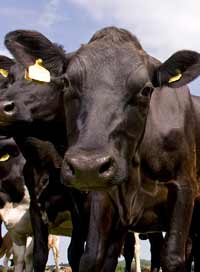Cheaper imports fail to dent dairy heifer replacement costs

Hundreds of dairy heifers are being imported from Europe by milk producers hunting for affordable replacements. But the flood of cattle shows no sign of undermining consistently strong cattle values, say traders.
The combination of expanding herds seeking extra cows, the constant stream of animals needed to replace TB losses, and the legacy of beef bulls in dairy herds mean farmers are seeking European dairy heifers, often significantly cheaper than at UK sales.
In some cases, heifers shipped from France, Germany and Holland might cost producers €1300 a head, compared with £1500-£1800 needed to secure a first rate, commercial freshly calved heifer at the ringside.
Auctioneer Derek Biss, at Sedgemoor livestock centre in Somerset, said that while he would expect interest in bulling and yearling heifer to wane in the early winter, plentiful, cheap fodder in the West Country was sustaining buyers’ appetites.
“Demand is certainly greater this year. Bulling heifers are £800-£1000 as a norm and yearling heifers are worth £600-£800. And the better commercial, NMR-recorded in-calf heifers are £1200-£1500.”
Trade was being helped by buoyant prices for store cattle, Mr Biss said. “Farmers who can sell two-year-old forward stores at £700-£800 a head can roll the money straight into dairy replacements without having to find any more money.”
Tighter supply in general seems to be supporting values too. “We are very short of pedigree sales down here in the West Country and TB is wiping out huge percentage of all age groups.”
Mr Biss, whose weekly sale of dairy cattle regularly attracts more than 60 head, said the supply situation was seeing more cattle imported from the Continent. “But they don’t produce the milk like a second- or third-calver and anything any good is £2000-plus.”
Tom Brooksbank of pedigree auctioneer Norton & Brooksbank said the appeal of importing dairy replacements was strong. “Trade may have eased very slightly in the last two or three weeks with fairly large-scale imports from Germany and Holland. Animals, delivered to your door on the English mainland for €1300 are very attractive.
“If you’re expanding your herd and you want 50 or 100 animals to milk, it’s awfully tempting to go to Germany. While issues like bluetongue still put many off, these animals are coming in by the hundred.”
Bovine TB slaughterings removed the equivalent of a 400-cow dispersal sale each week and the pool of replacement animals just wasn’t big enough, he added.
Gwilym Richards, who supplies animals through his business Dairy Cattle Direct as well as through the auction ring, said that despite many producers leaving milk there were still those hungry to expand. “In west Wales alone there are farmers looking for large numbers of cows, including one man getting into dairying and needing 150 milkers. There are also a number of rotary parlours going in and people moving from 300 cows to 500, and from 500 to 700.
“The cost of borrowing is relatively cheap at the moment and quota is not a limiting factor anymore. Some producers are looking to expand now and pay off borrowings in the short term.”
